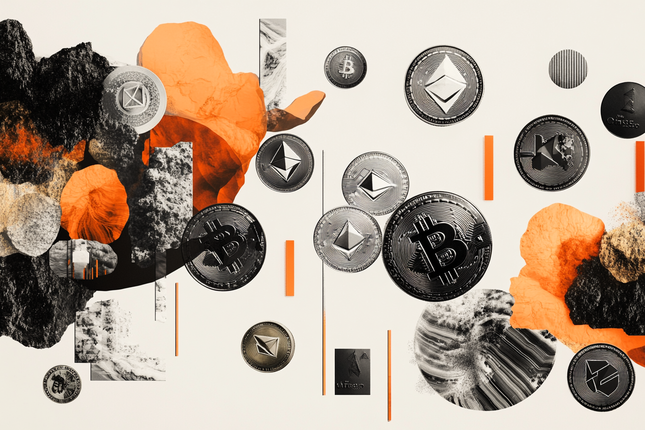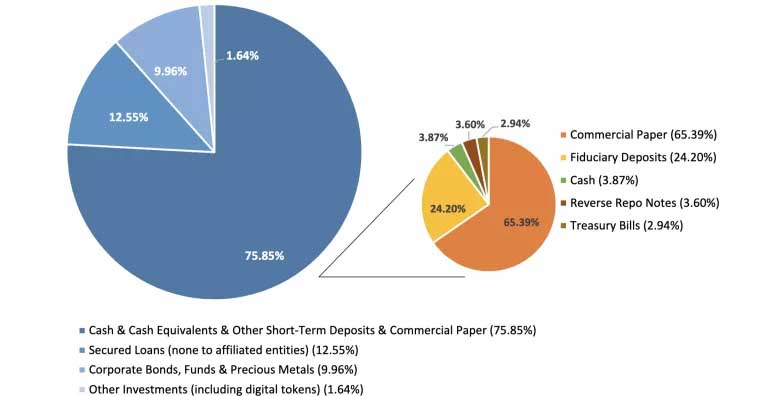Tether revealed the breakdown of its reserves for the first time, casting another sliver of light on the backing of USDT (-0.05%), the largest cryptocurrency pegged to the U.S. dollar.
Much remains murky, however, in part because the pie charts provided by Tether on Thursday make no mention of any independent review by an accounting firm. Moore Cayman, an audit firm in the Caribbean with five employees, has published two reports this year attesting that USDT is fully backed. But the auditor (part of the Moore Global confederation of accounting and consulting firms) did not detail what exactly is backing the token.
To be fair, other stablecoin issuers like Circle and Gemini don’t typically produce breakdowns of their reserve compositions at all. Gemini’s accountant, for example, states in its attestations that the client’s reserves are held in either FDIC-insured accounts at State Street Bank or a Goldman Sachs Asset Management money market fund that invests solely in U.S. Treasury securities. The percentage of each is not provided — but then again, both are considered highly liquid and creditworthy assets (“money-good,” in Wall Street parlance). The same cannot be said of all the assets on Tether’s balance sheet.
The new composition report is part of Tether’s efforts to stay in compliance with a settlement agreed to with the New York Attorney General’s office (NYAG) after the prosecutor investigated it and its sister crypto exchange Bitfinex over the cover-up of some $800 million in losses.
Bitfinex and Tether paid an $18.5 million dollar fine and agreed to provide quarterly breakdowns of its reserves as part of the settlement.
“Tether proposed ongoing publication of the reserve breakdown as part of our settlement agreement with the New York Attorney General’s Office, and we committed to make that information available to both the Attorney General’s office and the public,” Tether General Counsel Stuart Hoegner said in a statement. “Today’s publication reflects our ongoing dedication to transparency.”
The breakdown
Source: Tether
The breakdown states that the bulk of Tether’s reserves are in cash, equivalents or other short-term deposits, with the remainder in secured loans, corporate bonds and other investments. However, the first category is mostly made up of commercial paper, a form of corporate debt that can be easily converted to cash – or not, depending on the issuer and market conditions.
According to the breakdown, Tether’s reserves as of March 31, 2021 were composed of 75.85% cash and equivalents, 12.55% secured loans, 9.96% in corporate bonds and precious metals and 1.64% in other investments, including digital currencies. This is consistent with the company’s past statements but more precise.
The cash section was further broken out into different components: 65.39% commercial paper, 24.2% fiduciary deposits, 3.87% cash, 3.6% reverse repo notes and 2.94% Treasury bills.
It is unclear what the ratings are on the commercial paper or the corporate bonds, which agencies rated them or which companies issued them. Likewise, Tether declined to identify the borrowers of the loans or the collateral backing them.
“That’s a little iffy,” said Francine McKenna, an adjunct professor at American University’s Kogod School of Business, former auditor and writer of The Dig, a newsletter about accounting and corporate governance. “All commercial paper is not created equal, because of the credit ratings of various companies. Even some of the multinationals that used to be pristine are not so anymore.”
Do the math, and the unspecified commercial paper comes to just under half – 49% – of USDT’s collateral.
Tether’s reserves are partly invested in bitcoin (BTC, -10.58%), which makes up less than 1.64% of its overall backing (in the “other investments” category) and gold, which makes up less than 9.96% of its backing (in the “precious metals” category).
While Thursday’s publication isn’t attested to, the reserves would be the same that Moore Cayman would have examined in publishing assurance reports for the company. The firm published its first report at the end of March, addressing the USDT stablecoin’s backing as of Feb. 28, 2021. Another report was published last month, attesting to the backing as of March 31.
The backstory
USDT is a key piece of plumbing for the roughly $2 trillion global crypto market. Traders use it to quickly transfer dollar value between exchanges to capture arbitrage opportunities when a bank wire is unavailable or too slow.
The opacity of Tether’s operations, however, has fanned the flames of speculation by critics who question USDT’s backing and conjecture that the company props up the market by printing tokens.
Tether has a long history of attempting to verify its reserves, but without providing much in the way of documentation. The company first hired audit firm Friedman LLP, which produced a preliminary report that stated the amount of USDT Tether had issued was backed by its cash reserves, though with several caveats.
The firm then tapped law firm Freeh Sporkin & Sullivan LLP to publish a report on its backing, but this too was hedged.
In late 2018 Tether’s bank, Bahamas-based Deltec Bank & Trust, published a letter with an illegible signature stating the company had $1.8 billion in reserves, matching the amount of USDT in circulation.
During the NYAG’s investigation, Hoegner revealed that at one point, Tether was only about 74% backed by reserves.
Despite all this, USDT has traded at or near $1 for nearly all of its history.
This year, Tether has committed to publishing regular attestations through Moore Cayman.
All writers’ opinions are their own and do not constitute financial advice in any way whatsoever. Nothing published by CoinDesk constitutes an investment recommendation, nor should any data or Content published by CoinDesk be relied upon for any investment activities. CoinDesk strongly recommends that you perform your own independent research and/or speak with a qualified investment professional before making any financial decisions.
Recommended Content
Editors’ Picks

Bitcoin holds $84,000 despite Fed’s hawkish remarks and spot ETFs outflows
Bitcoin is stabilizing around $84,000 at the time of writing on Thursday after facing multiple rejections around the 200-day EMA at $85,000 since Saturday. Despite risk-off sentiment due to the hawkish remarks by the US Fed on Wednesday, BTC remains relatively stable.

Crypto market cap fell more than 18% in Q1, wiping out $633.5 billion after Trump’s inauguration top
CoinGecko’s Q1 Crypto Industry Report highlights that the total crypto market capitalization fell by 18.6% in the first quarter, wiping out $633.5 billion after topping on January 18, just a couple of days ahead of US President Donald Trump’s inauguration.

Top meme coin gainers FARTCOIN, AIDOGE, and MEW as Trump coins litmus test US SEC ethics
Cryptocurrencies have been moving in lockstep since Monday, largely reflecting sentiment across global markets as United States (US) President Donald Trump's tariffs and trade wars take on new shapes and forms each passing day.

XRP buoyant above $2 as court grants Ripple breathing space in SEC lawsuit
A US appellate court temporarily paused the SEC-Ripple case for 60 days, holding the appeal in abeyance. The SEC is expected to file a status report by June 15, signaling a potential end to the four-year legal battle.

Bitcoin Weekly Forecast: Market uncertainty lingers, Trump’s 90-day tariff pause sparks modest recovery
Bitcoin (BTC) price extends recovery to around $82,500 on Friday after dumping to a new year-to-date low of $74,508 to start the week. Market uncertainty remains high, leading to a massive shakeout, with total liquidations hitting $2.18 billion across crypto markets.

The Best brokers to trade EUR/USD
SPONSORED Discover the top brokers for trading EUR/USD in 2025. Our list features brokers with competitive spreads, fast execution, and powerful platforms. Whether you're a beginner or an expert, find the right partner to navigate the dynamic Forex market.
